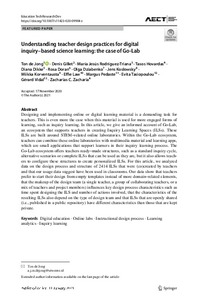Understanding teacher design practices for digital inquiry–based science learning: the case of Go-Lab
de Jong Ton; Gillet Denis; Rodríguez-Triana María Jesús; Hovardas Tasos; Dikke Diana; Doran Rosa; Dziabenko Olga; Koslowsky Jens; Korventausta Miikka; Law Effie; Pedaste Margus; Tasiopoulou Evita; Vidal Gérard; Zacharia Zacharias C.
https://urn.fi/URN:NBN:fi-fe2021042823340
Tiivistelmä
Designing and implementing online or digital learning material is a
demanding task for teachers. This is even more the case when this
material is used for more engaged forms of learning, such as inquiry
learning. In this article, we give an informed account of Go-Lab, an
ecosystem that supports teachers in creating Inquiry Learning Spaces
(ILSs). These ILSs are built around STEM–related online laboratories.
Within the Go-Lab ecosystem, teachers can combine these online
laboratories with multimedia material and learning apps, which are small
applications that support learners in their inquiry learning process.
The Go-Lab ecosystem offers teachers ready–made structures, such as a
standard inquiry cycle, alternative scenarios or complete ILSs that can
be used as they are, but it also allows teachers to configure these
structures to create personalized ILSs. For this article, we analyzed
data on the design process and structure of 2414 ILSs that were
(co)created by teachers and that our usage data suggest have been used
in classrooms. Our data show that teachers prefer to start their design
from empty templates instead of more domain–related elements, that the
makeup of the design team (a single teacher, a group of collaborating
teachers, or a mix of teachers and project members) influences key
design process characteristics such as time spent designing the ILS and
number of actions involved, that the characteristics of the resulting
ILSs also depend on the type of design team and that ILSs that are
openly shared (i.e., published in a public repository) have different
characteristics than those that are kept private.
Kokoelmat
- Rinnakkaistallenteet [27094]
